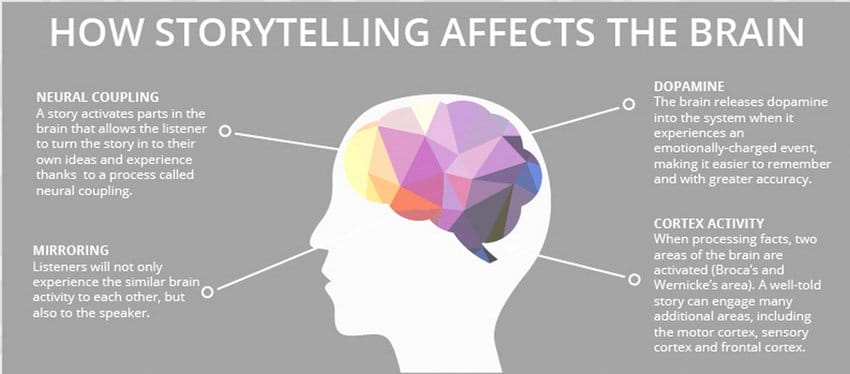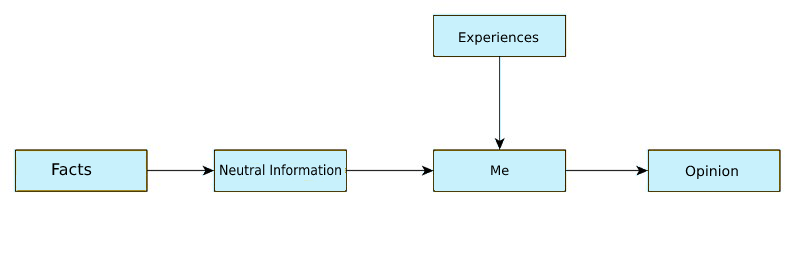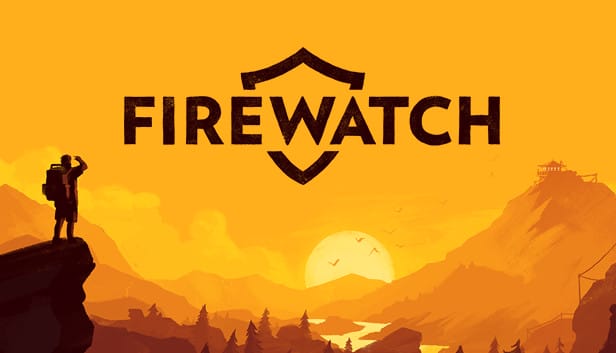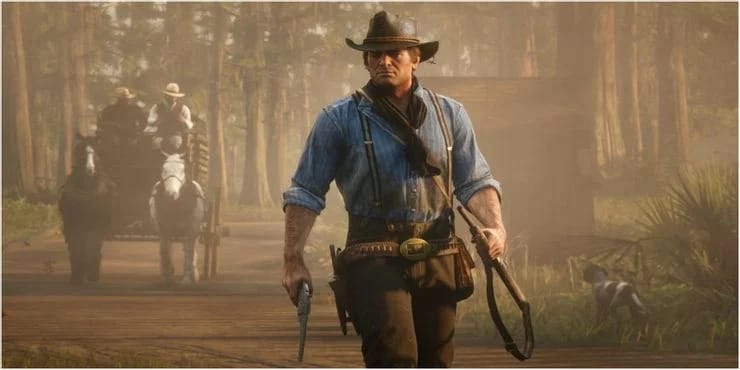Telling Stories
One of the main activities of humankind is telling stories, independently of races, or the period in time, is that We all tell stories. When we describe the day just passed to our partner over dinner, we’re telling a story. When at the pub with our friends we list the problems we’re having at work, we’re telling a story. In this article we are going to overview the meaning of Interactive Storytelling and Why and How We Tell Stories.
Every day, we are also passive listeners of other people’s stories.When we read a book, the author is telling us a story. When we watch a commercial on television, the advertisers are telling us a story. When we listen to a song, the singer is telling us a story.
Most of the time, however, we don’t realize we’re telling stories. We think we’re just relaying the facts, when in reality, we’re selecting the most relevant facts, arranging them so they make the most sense, and leaving out the ones that don’t fit our narrative. We’re also using language to paint a picture, using words like “seemed” or “felt” to signal to our listeners that we’re not being literal. We’re also using words like “maybe” or “probably” to signal uncertainty.

Why and How We Tell Stories Table of Contents
1. Intro to storytelling
If you think about it, we make up stories every day and listen to them. The whole world is a kind of cacophony, an endless spiral of stories, narratives and anecdotes that mix and move from person to person.
We are stories that tell other stories.
These stories are told and listened to because they need to be told.
This has always been the case.
Since the dawn of humanity, we have been telling stories.
Storytelling is an activity that humans have engaged in since before language and writing were invented.

The first thing to understand about storytelling is that it’s an activity. It has rules, patterns, and structures. Just like we have grammar rules that govern the way we speak, we have storytelling rules that govern the way we communicate through stories. And just like we have rules for grammar and spelling, we have rules for good storytelling.
But what is the purpose of storytelling when we tell them? And how can these things be applied to video game development?
2. What are stories?
This is an interesting and important question. What are stories?
Storytelling is a form of communication that uses narrative to influence a person’s emotions, attitudes, and behavior.
It uses a sequence of events (or plot) to convey a message.
There are many different types of stories, including narratives, anecdotes, and jokes.
In games the stories have been gradually grow in complexity as the systems evolved in performance and capacity, up to a point where complex stories can be told through the digital language of the computer.
3. Why do people tell stories?
Telling stories is one of the main ways we pass knowledge from one person to another. We use stories to describe our experiences to others, to entertain them, to arouse their emotions, to educate them, and to persuade them. Storytelling has many different meanings and purposes. Sometimes we tell stories to tell the truth, sometimes to dispel fears, and sometimes simply for fun.
Storytelling is a way to express our individuality and creativity, and to show an aspect of our thinking that we might not otherwise be able to express.
But telling a story and telling a fact are two very different things.
Telling or presenting a fact simply means revealing the relevant events. Journalists, for example, present the facts as they are, without personal details, opinions, or feelings. This allows the listener to form his or her own judgment.
You can add your own opinion (even indirectly, through facial expressions, tone of voice, or, if you’re Italian like me, gestures), highlight the parts that are important to you, and generally filter the facts through your own perspective and cultural background.
And instead of just listing events, we tailor our stories to convey the message we want our audience to hear. We don’t want our listeners to have their own opinions; we want them to be ours first and foremost.
We do this because we hope our narratives will allow us to elaborate a response.

They’re also one of the main ways we form social bonds. One of the reasons we like to spend time with other people is because they tell us stories.
We use words and language to paint a picture, to describe our experiences, and to signal to our listeners what we’re saying. We also use words and language to signal uncertainty, to draw a parallel between two things, to ask a question, and to provide background information. We use language to convey emotion, and we use language to convey complex meaning.
We are also using it to convey knowledge and experience that in other formats wouldn’t be possible due to the limitations. For example in business presentations and training, a lot of speakers are using storytelling and stories to resonate and engage with their audiences.
We want the people who listen to us to enjoy our stories and be moved by them. We want people to enjoy our stories, to be moved by them, to empathize with us, to be angry with us, to be comforted by us. Even if you are not the subject of your story, tell it to impress others, maybe even to share your feelings.
4. Some Examples of StoryTelling
Case 1: You are sitting in the waiting room of your doctor, and you are watching TV. A journalist tells you about the corruption of an important businessman and explains that many workers will lose their jobs as a result.
Reaction and relation: The information is presented in a neutral way, and you process it according to your own situation and decide how to react. If you are a worker, you will first feel sympathy and then anger. If you are a writer, you may become curious and want to write about the story. If you are a wealthy entrepreneur, you may wonder if you can just take over a fallen man’s business. However you respond, it’s up to you.

An example of a story
Case 2: A few minutes later, a couple comes and sits next to you in the waiting room. They start talking and tell you how desperate they are because the husband is one of those unemployed workers with 3 high school Children and a mortgage to pay.
Projecting: now the information is presented to you from another person point of view. His story is full of anger and disappointment. You process it according to your own personal circumstances, but you are affected by the way they tell the story. Your reaction may be similar to the one described in the first example, or it may be different, influenced by this family experience and the struggles that may have.
The better the storyteller can tell the story, the more influence on the listener.
In other words, the purpose of telling a story is to convey a message and elicit a response from the listener.
In other words: We tell stories to get our message across, with the goal of eliciting a response from the audience.
5. How to tell a great story
Even though storytelling is something we do everyday, it’s far from being a science.
There are no “rules” to tell a great story. And there are no “right” ways to tell a story.Fortunately, the process of storytelling is relatively simple.
Great stories come from great experiences and more importantly, from commonalities between us all: our roles as humans and as part of the natural world we share this planet with.
Tools of the trade
We use tools to tell our stories, not just paper and pencils and microphones. As we’ll see in more detail in the next section, there are tools we use without even realizing it.
The tone of our voice when we speak, for example, is one of these tools. Emphasizing words, speeding up or slowing down the narrative are all tools we use to get the listener to respond in the way we want. As storytellers, we have the power to direct our interlocutors’ responses toward our desired goal.
As professional storytellers (since this article aims to provide tips on how to apply the concept of storytelling to a product like a video game), we have a duty to do so.
We can’t write a story without knowing where we want to take the player and what reaction we want to evoke. Otherwise, our stories would be very weak.
Otherwise, our stories will be very weak.
An interdisciplinary experience
The first set of tools is the interdisciplinary experience. As video game storytellers, we can use many things to tell our stories. For example, the background music, the lighting of a scene, or the color correction of the game camera.
But to use these tools, you have to know them. Below is some advice on how to get the most out of each of these tools. You are a game developer, not an artist or sound designer. However, it’s not possible not to know how each instrument works. If you ignore the basic rules of directing, you’ll end up writing cutscenes that have no rhythm or whose angles are not suitable to convey your message to the player.
Of course, if you have a large team, you’ll have people who specialize in their field, and they’ll determine the final result. However, if you know some of their areas of expertise, you can find common ground with them, engage constructively with them, and suggest their vision as the story author.
For example, if you want to express fear, anxiety, or discomfort in a game sequence, you can use certain background sounds or give the camera certain angles. But to do this, you need to know how setting the camera angle affects the player’s reaction. The camera, the music, the sound, the colors – all of these are part of storytelling and are tools to be used.

You can find in this article some of the best story driven games in the history of videogames.
- 10 The Last Of Us
- 9 Horizon Zero Dawn
- 8 Detroit: Become Human
- 7 Knights Of The Old Republic
- 6 God Of War
- 5 Persona 5 Royal
- 4 That Dragon, Cancer
- 3 Mass Effect: Legendary Edition
- 2 Red Dead Redemption 2
- 1 Dragon Age: Origins
So the more you know about them, the better they become.

Life experience
The second tool is life experience. One of the first things I notice when I teach game design is that students think they might be good game designers because they play a lot. Of course, it’s important to play often and know the relevant markets. But if all you do is play, you tend to repeat what you’ve seen in others’ games, and that’s not a good way to be a storyteller.
Rather, engaging in something other than gaming will expand your knowledge and education.

One of the secrets of good storytelling is knowing who you are speaking to. Then, adjust the way you tell the story so that it reaches the target audience as well as possible.
For example, if you want to appeal to people who like opera, you first need to get them to attend ten performances at the opera house. But that’s not all. You need to go hiking, canoeing, or paint a picture.
And why?
Because you’ll learn new and different tools and ways to deal with them that will open up new storytelling possibilities. The more you know, the more you learn and try, the better you get at storytelling.
6 Creating a story
One of the most important differences between humans and animals is the ability to tell stories. Many animals are able to communicate with each other and convey information to each other, such as where they can find food or where there is danger.
But just like us, animals can tell each other stories. While they sleep, they can tell each other stories through dreams. Recently, I’ve been watching my cat. When she sleeps, she often makes the same sounds and mouth movements as when she catches insects in the house. As I was looking into this, I found an article that said cats dream about things that haven’t even happened yet.
However, the main difference between our dreams and theirs is that animals don’t have imaginations to make them up. Their dreams are based on real facts, even if they never happened. Instead, we can dream about things that not only never happened, but could never happen (raise your hand if you’ve never dreamed of having psychic powers!) ), we are free to dream and make up stories based on them.
Imagination is the third tool to tell a story. We have been exercising this one from tender ages, but with the growing into adults, we usually forgot that we can be imaginative, even if we think we are boring.
7. Collaboration and cooperation
Another big difference between us and animals is that we can cooperate with each other based on the ideas of others.
For example, one ant may say to another, “There is food in this direction. But the third ant, observing the conversation, cannot add, “There is water further in.” The third ant must start a new conversation from scratch to get its message across. This may seem like a small limitation, but it is the reason why mankind has been able to make so many advances in science. It is because when we study something, we start from what others have studied, demonstrated and taught us, such as through books. We don’t have to start from scratch, but can focus on the next step.
This is a collaborative way of telling a story, and the fourth tool, “collaboration,” is a way of “interaction.”
The fourth tool, “collaboration,” is a type of “interaction,” and we can define interaction as The fourth tool, collaboration, is a type of “interaction,” and can be defined as “the mutual exchange of information between two parties through a medium.”
8. Storytelling in video games
With this long preface in mind, we can finally get to the heart of the topic. We have clarified what storytelling is, what the purpose of storytelling is, what tools should be used, and we have also given a definition of the word interactive. This is really important because with the emergence of video games, a form of storytelling that was once considered “experimental” has become one of the most popular and relevant forms of modern storytelling: interactive storytelling.
This is why storytelling in video games is so important.
In fact, video games can make storytelling a unique and in many ways new experience because they can organize messages and evoke very complex and powerful responses.
When we tell a story, we’re using the tools of storytelling.
9. The Storyteller’s Tools
The storyteller’s tools play a critical role in the creation of interactive stories.
By understanding how the tools work and how they can be used, you will gain insights into how to craft the most engaging and satisfying experiences in your games.It’s not that storytelling is a science — it is a craft with many different elements, including many different skills.
But it is important to understand that, like any craft, there are certain aspects of storytelling that are more important than others.For example, while telling a story mode is crucial for creating an engaging experience, telling a story on an iPad may be less so than telling one on an Android phone due to the smaller screen size and lack of ergonomics . T
here are other factors as well: What kind of game are you making? How much time do you have? What’s the goal? How will you accomplish it?
10. Narrative Design and structure
The most common narrative structure is called linear: it’s a series of events that gradually develops into a satisfying conclusion. It’s the narrative structure that most marketers are used to.
However, what might come as an unexpected surprise when it comes to storytelling are the “non-linear” structures.These structures have the potential of turning some very common marketing messages and communication tools into something more than just a series of events and activities.
They can be used to create something more than just a series of events and activities. In other words, they can be used to tell stories.How?
This question has been answered by game designers, who have developed various kinds of interactive stories with various kinds of narratives:The story is not only about the main protagonists, but their interactions with other characters and their actions towards others in the game world.
The story is also about the overall theme and setting in which these protagonists are operating within. The most important thing for a player is that he/she has fun when playing a particular game or movie – so this “story” (in this case) should make him/her feel like he/she is “part” of something larger than himself or herself (or herself as part of something bigger).
A good story allows players to experience more than one viewpoint while playing: they interact with characters from different generations, different stories, different situations that change depending on how they react to them.
When it comes to game development, and thinking in Stories, lore, quests, character dialogue – narrative is the most important element. It gives life and history to even the smallest things and evokes emotions that we wouldn’t normally perceive.
So what exactly is a narrative? And how can a narrator breathe life into an empty world?
Narrative and its importance in games
In film, the audience can sit back and visually follow a particular plot, but the experience is almost always the same. The same is true for books, and although repeated reading of the same book can lead to new and richer concepts, the structure of the story is always the same.
In video games, however, the player interacts with the story on an entirely different level. The player becomes the story. The player’s actions and choices shape the way the story is told, and no one’s first experience during gameplay is the same.
Why and How We Tell Stories
What is a narrative design?
According to NarrativeDesign.org, compiled by Stephen Dinehart, a pioneer in narrative design, the role of the narrative designer in the game development process is to “create compelling story elements that support the narrative and define a system to deliver them to the player.

They are essentially the authors of the video game. They may contribute creatively to the design process of the game, but in reality their primary role is to move the narrative from one scene to the next. For example, if a designer wants to change from a desert planet to an arctic landscape, they will ask the narrator to come up with a rational and creative reason for doing so.
It is important for the narrator to understand and visualize the tone of the game. Based on the main plot, write connections between objects and scenes, such as why this stone is in this place. These connections, no matter how small, can make or break a game.
11. Conclusion
I’m sure that you’re thinking, “Wait, I can do this! I’m a creative person. I know how to write stories. I just need to get my hands on a good story!”The problem is that for most of the world, telling stories is not the easiest thing in the world because of the requirements of being very structured as to engage correctly with the people that are “consumming” the story.
We will be expanding this article over time, don’t´forget to check it back from time to time. For more interesting articles don’t forget to check our blog.



